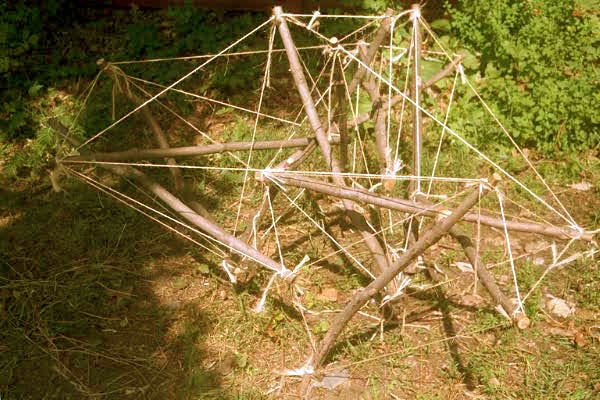
2ν Octa Double-Layer Tensegrity Dome

Here are some rough dome beginnings you won't find in the press releases or prospectus.
The above photo is of the second outdoor tensegrity I assembled. The move outdoors was inspired by the fall of a large maple tree during a windy storm in the spring of 1997, a windfall for tensegrity research. I used 50-inch lengths of one-inch-diameter (approx) branches for the struts. At each end, two 1/4-inch holes were drilled through the strut at right angles, one beside the other, one inch from either end (a total of four holes, in other words eight entrances, for each strut) to yield a 48-inch working length for each strut.
In addition, I had a large spool of sisal twine I had bought for the garden. The tests I had done of the twine weren't promising, at least in retrospect. It had "memory" problems -- once it was stretched, it didn't rebound when the load was removed. It also responded significantly to moisture in the air becoming tighter when the air was drier.
On June 2, 1997, I had completed the design for a "2ν Octa Double-Layer Tensegrity Dome" which derived from an earlier design for the sphere. With that as a basis, I completed my first assembly of the 2ν dome on June 20, 1997. I didn't use outer binding tendons, which means the four tripods of which the dome is composed were not connected to each other by tendon triangles.
The first assembly had problems with loose tendons. A contributing factor was that one of the struts of the top symmetric tripod bowed. The tautness problem I fixed, at least temporarily, by tying an additional triangle of tendons to each convergence as shown in the figure below:
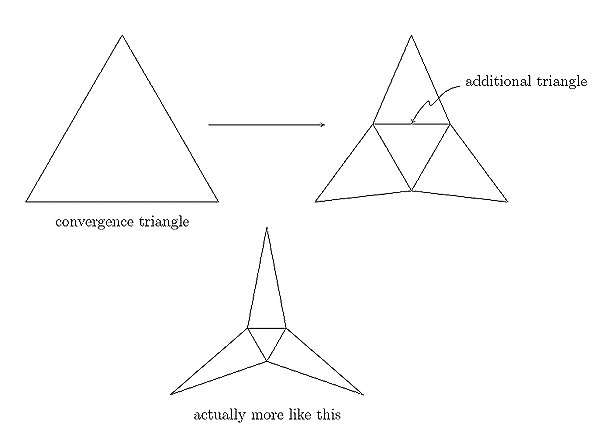
2ν Octa Double-Layer Tensegrity Dome:
Scheme for Tightening Loose Tendons
Having to fend off bugs was a nuisance as well, but later projects gave me a more positive experience of the outdoors. Spending the day outside fiddling with some project was enjoyable just for getting acquainted with the bugs etc.
So I spent a few days tightening the tendons since each day when I'd come out another would be loose. I finally took it apart and assembled a second version which I believe is what you're looking at in the above photo and the one directly below. It took two attempts since my ad hoc adjustment for the hubs was too large for the first attempt and several tendons broke during assembly.
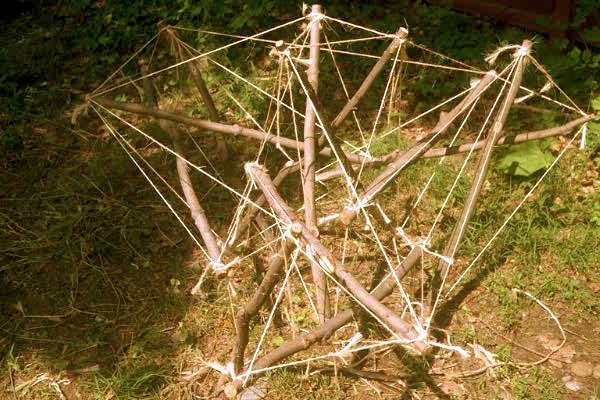
2ν Octa Double-Layer Tensegrity Dome (Another View)
I was pleased with the finished result, but in succeeding days I was back to making ad hoc adjustments to tighten loose tendons. I finally concluded that with this medium (maple struts and especially sisal twine) the intial design is just a starting point and the final configuration (if it can be said I ever reached such a thing) is the result of ad hoc adjustments to remove the slackness which appears.
I then moved on to assemble a 6ν octa double-layer dome using the design from the first edition of my book. The copious branches from the fallen maple weren't sufficient and I had to buy additional hardwood stakes. I also ended up going to the hardware store for more sisal twine. I finished assembly on August 14, 1997, having started on August 4. A photo of the result is below:
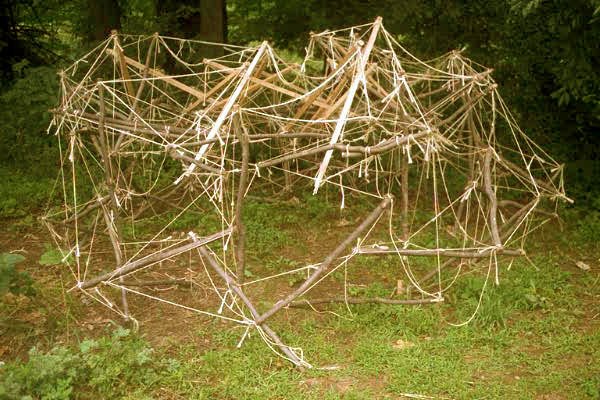
6ν Octa Double-Layer Tensegrity Dome: Realization
I concluded that neither sisal twine nor tree branches were satisfactory building materials. The structure was like a pillow. The last straw was when the tendons started to break. The inner and outer convergence tendons were the most vulnerable and broke at the knots. I did climb inside for a look.
I also concluded that, aside from the materials I was using, my dome design was going to need a scheme for stabilizing the base. The structure fell over to one side easily. Succeeding domes had some additional guys which I introduced into the design on August 18. I also explored designs with sphere truncation strategies where the outer tripod convergences were secured directly to the ground rather than indirectly via guys. I've never assembled structures based on these alternative truncations as entry into the structure seemed problematic. A picture of the design I was working from (no guys) is below:
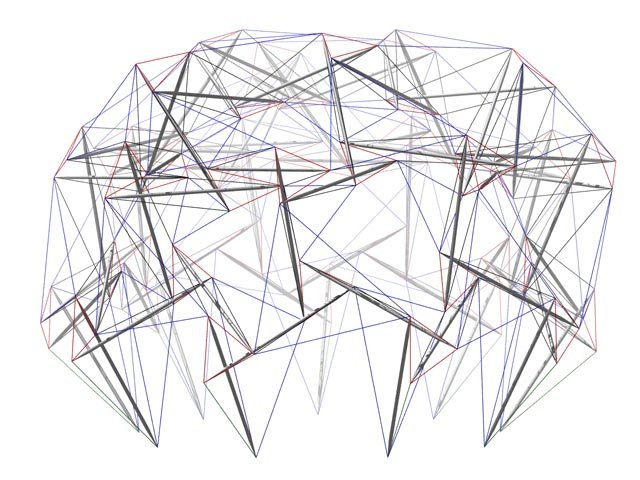
6ν Octa Double-Layer Tensegrity Dome: Design
After a few days, I took the sisal domes apart. I retrieved the twine, and it proved very useful in the garden in succeeding years. I think the birds incorporated a fair amount into their nests. For dome building materials I moved on to hardwood stakes and nylon twine, both of which had their problems, but these seemed much more manageable in contrast to sisal twine and maple tree branches. This next design iteration (which had to wait until May 1998) resulted in the design you will find described in my press release and prospectus.


